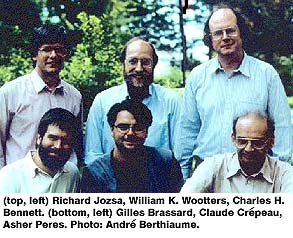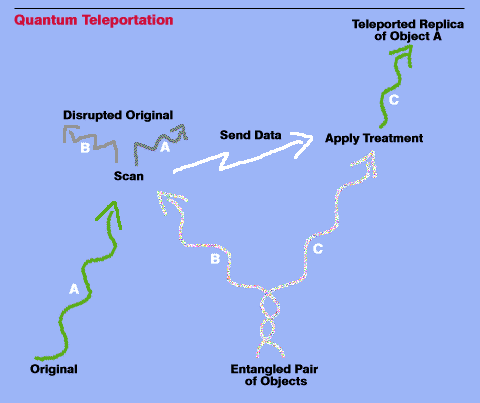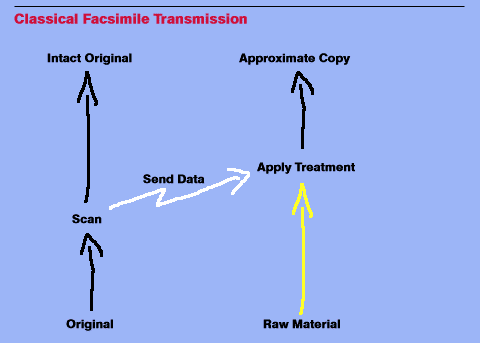Time Travel Research Center © 2005 Cetin BAL - GSM:+90 05366063183 -Turkey/Denizli
Quantum Teleportation
Teleportation is the name given by science fiction writers to the feat of making an object or person disintegrate in one place while a perfect replica appears somewhere else. How this is accomplished is usually not explained in detail, but the general idea seems to be that the original object is scanned in such a way as to extract all the information from it, then this information is transmitted to the receiving location and used to construct the replica, not necessarily from the actual material of the original, but perhaps from atoms of the same kinds, arranged in exactly the same pattern as the original. A teleportation machine would be like a fax machine, except that it would work on 3-dimensional objects as well as documents, it would produce an exact copy rather than an approximate facsimile, and it would destroy the original in the process of scanning it. A few science fiction writers consider teleporters that preserve the original, and the plot gets complicated when the original and teleported versions of the same person meet; but the more common kind of teleporter destroys the original, functioning as a super transportation device, not as a perfect replicator of souls and bodies.
 In 1993 an international group of six scientists, including IBM Fellow
Charles H. Bennett, confirmed the intuitions of the majority of science
fiction writers by showing that perfect teleportation is indeed possible in
principle, but only if the original is destroyed. Meanwhile, other
scientists are planning experiments to demonstrate teleportation in
microscopic objects, such as single atoms or photons, in the next few years.
But science fiction fans will be disappointed to learn that no one expects
to be able to teleport people or other macroscopic objects in the
foreseeable future, for a variety of engineering reasons, even though it
would not violate any fundamental law to do so.
In 1993 an international group of six scientists, including IBM Fellow
Charles H. Bennett, confirmed the intuitions of the majority of science
fiction writers by showing that perfect teleportation is indeed possible in
principle, but only if the original is destroyed. Meanwhile, other
scientists are planning experiments to demonstrate teleportation in
microscopic objects, such as single atoms or photons, in the next few years.
But science fiction fans will be disappointed to learn that no one expects
to be able to teleport people or other macroscopic objects in the
foreseeable future, for a variety of engineering reasons, even though it
would not violate any fundamental law to do so.
 Until recently, teleportation was not taken seriously by scientists,
because it was thought to violate the uncertainty principle of quantum
mechanics, which forbids any measuring or scanning process from extracting
all the information in an atom or other object. According to the uncertainty
principle, the more accurately an object is scanned, the more it is
disturbed by the scanning process, until one reaches a point where the
object's original state has been completely disrupted, still without having
extracted enough information to make a perfect replica. This sounds like a
solid argument against teleportation: if one cannot extract enough
information from an object to make a perfect copy, it would seem that a
perfect copy cannot be made. But the six scientists found a way to make an
end-run around this logic, using a celebrated and paradoxical feature of
quantum mechanics known as the Einstein-Podolsky-Rosen effect. In brief,
they found a way to scan out part of the information from an object A, which
one wishes to teleport, while causing the remaining, unscanned, part of the
information to pass, via the Einstein-Podolsky-Rosen effect, into another
object C which has
never been in contact with A. Later, by applying to C a treatment depending
on the scanned-out information, it is possible to maneuver C into exactly
the same state as A was in before it was scanned. A itself is no longer in
that state, having been thoroughly disrupted by the scanning, so what has
been achieved is teleportation, not replication.
Until recently, teleportation was not taken seriously by scientists,
because it was thought to violate the uncertainty principle of quantum
mechanics, which forbids any measuring or scanning process from extracting
all the information in an atom or other object. According to the uncertainty
principle, the more accurately an object is scanned, the more it is
disturbed by the scanning process, until one reaches a point where the
object's original state has been completely disrupted, still without having
extracted enough information to make a perfect replica. This sounds like a
solid argument against teleportation: if one cannot extract enough
information from an object to make a perfect copy, it would seem that a
perfect copy cannot be made. But the six scientists found a way to make an
end-run around this logic, using a celebrated and paradoxical feature of
quantum mechanics known as the Einstein-Podolsky-Rosen effect. In brief,
they found a way to scan out part of the information from an object A, which
one wishes to teleport, while causing the remaining, unscanned, part of the
information to pass, via the Einstein-Podolsky-Rosen effect, into another
object C which has
never been in contact with A. Later, by applying to C a treatment depending
on the scanned-out information, it is possible to maneuver C into exactly
the same state as A was in before it was scanned. A itself is no longer in
that state, having been thoroughly disrupted by the scanning, so what has
been achieved is teleportation, not replication.
As the figure to the left suggests, the unscanned part of the information is conveyed from A to C by an intermediary object B, which interacts first with C and then with A. What? Can it really be correct to say "first with C and then with A"? Surely, in order to convey something from A to C, the delivery vehicle must visit A before C, not the other way around. But there is a subtle, unscannable kind of information that, unlike any material cargo, and even unlike ordinary information, can indeed be delivered in such a backward fashion. This subtle kind of information, also called "Einstein-Podolsky-Rosen (EPR) correlation" or "entanglement", has been at least partly understood since the 1930s when it was discussed in a famous paper by Albert Einstein, Boris Podolsky, and Nathan Rosen. In the 1960s John Bell showed that a pair of entangled particles, which were once in contact but later move too far apart to interact directly, can exhibit individually random behavior that is too strongly correlated to be explained by classical statistics. Experiments on photons and other particles have repeatedly confirmed these correlations, thereby providing strong evidence for the validity of quantum mechanics, which neatly explains them. Another well-known fact about EPR correlations is that they cannot by themselves deliver a meaningful and controllable message. It was thought that their only usefulness was in proving the validity of quantum mechanics. But now it is known that, through the phenomenon of quantum teleportation, they can deliver exactly that part of the information in an object which is too delicate to be scanned out and delivered by conventional methods.
 This figure compares conventional facsimile transmission with quantum
teleportation (see above). In conventional facsimile transmission the
original is scanned, extracting partial information about it, but remains
more or less intact after the scanning process. The scanned information is
sent to the receiving station, where it is imprinted on some raw material (eg
paper) to produce an approximate copy of the original. In quantum
teleportation two objects B and C are first brought into contact and then
separated. Object B is taken to the sending station, while object C is taken
to the receiving station. At the sending station object B is scanned
together with the original object A which one wishes to teleport, yielding
some information and totally disrupting the state of A and B. The scanned
information is sent to the receiving station, where it is used to select one
of several treatments to be applied to object C, thereby putting C into an
exact replica of the former state of A.
This figure compares conventional facsimile transmission with quantum
teleportation (see above). In conventional facsimile transmission the
original is scanned, extracting partial information about it, but remains
more or less intact after the scanning process. The scanned information is
sent to the receiving station, where it is imprinted on some raw material (eg
paper) to produce an approximate copy of the original. In quantum
teleportation two objects B and C are first brought into contact and then
separated. Object B is taken to the sending station, while object C is taken
to the receiving station. At the sending station object B is scanned
together with the original object A which one wishes to teleport, yielding
some information and totally disrupting the state of A and B. The scanned
information is sent to the receiving station, where it is used to select one
of several treatments to be applied to object C, thereby putting C into an
exact replica of the former state of A.
To learn more about quantum teleportation, see the following articles:
- C.H. Bennett, G. Brassard, C. Crepeau, R. Jozsa, A. Peres, and W.
Wootters,
"Teleporting an Unknown Quantum State via Dual Classical and EPR Channels",
Phys. Rev. Lett. vol. 70, pp 1895-1899 (1993)
(the original 6-author research article). - Tony Sudbury, "Instant Teleportation", Nature vol.362, pp 586-587 (1993) (a semipopular account).
- Ivars Peterson, Science News, April 10, 1993, p. 229. (another semipopular account).
- Samuel Braunstein, A fun talk on teleportation
- For recent experimental and theoretical papers, do a title search on "teleportation" in the Los Alamos E-print Archive
Alıntı: http://www.research.ibm.com/quantuminfo/teleportation
Hiçbir yazı/ resim izinsiz olarak kullanılamaz!! Telif hakları uyarınca bu bir suçtur..! Tüm hakları Çetin BAL' a aittir. Kaynak gösterilmek şartıyla siteden alıntı yapılabilir.
The Time Machine Project © 2005 Cetin BAL - GSM:+90 05366063183 -Turkiye/Denizli
Ana Sayfa /index /Roket bilimi /![]() E-Mail /CetinBAL/Quantum Teleportation-2
E-Mail /CetinBAL/Quantum Teleportation-2
Time Travel Technology /Ziyaretçi Defteri /UFO Technology/Duyuru